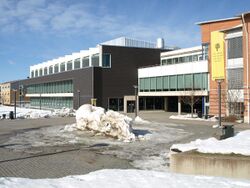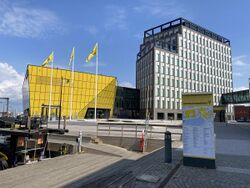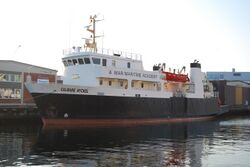Linnaeus University
Topic: Organization
 From HandWiki - Reading time: 4 min
From HandWiki - Reading time: 4 min
Linnéuniversitetet | |
| Latin: Universitas Linnæus | |
Former names | Växjö Universitet (1999-2009)
Högskolan i Växjö (1977-1999) Högskolan i Kalmar (1977-2009) |
|---|---|
| Type | Public university |
| Established | 2010 (1967) |
| Endowment | SEK 1.5 billion |
| Budget | 1761 Mkr (2016)[1] |
| Rector | Peter Aronsson |
Academic staff | 2,000[1] |
| Students | 15,000 FTE[1] |
| 302 (F167+M135) | |
| Location | Växjö & Kalmar , Småland , Sweden |
| Campus | Urban |
| Affiliations | EUA, SUHF |
| Website | lnu.se |
Linnaeus University (LNU) (Swedish: Linnéuniversitetet) is a state university in the Swedish historical province (landskap) Småland, with campuses located in Växjö and Kalmar. Linnaeus University was established in 2010 by a merger of former Växjö University and Kalmar University (Högskolan i Kalmar), and is named in honour of the Swedish botanist Carl Linnaeus.[1]
History
Växjö University began as a local department of Lund University in 1967. The department became an independent university college in 1970 and was granted full university status in 1999.
Kalmar University was similarly a university college, founded in 1977. Though not a university by the Swedish definition, it had been entitled to issue doctoral degrees in the natural sciences since 1999.
Logo
The university's logo is a stylized tree. The origin is a drawing made by the Swedish scientist Carl Linnaeus taken from his 1725 publication Örtabok.[2] While the tree is said to be a symbol of May and to represent the power of growth, it also symbolizes the university's ambition to be a global university with the region as its base and the world as its arena.
Faculties and schools
Faculties[3]
- Faculty of arts and humanities.
- Faculty of health and life sciences.
- Faculty of social sciences.
- Faculty of technology.
- The school of business and economics - received AACSB accreditation in 2022.[4]
In addition to the five faculties, there is also the Board of Teacher Education.
Departments
- Department of Biology and Environmental Science
- Department of Building Technology
- Department of Built Environment and Energy Technology
- Department of Chemistry and Biomedical Sciences
- Department of Computer Science and Media Technology
- Department of Criminology and Police Work
- Department of Cultural Sciences
- Department of Design
- Department of Economics and Statistics
- Department of Education and Teachers' Practice
- Department of Film and Literature
- Department of Forestry and Wood Technology
- Department of Health and Caring Sciences
- Department of Informatics
- Department of Languages
- Department of Management
- Department of Marketing and Tourism Studies
- Department of Mathematics
- Department of Mechanical Engineering
- Department of Media and Journalism
- Department of Medicine and Optometry
- Department of Music and Art
- Department of Pedagogy and Learning
- Department of Physics and Electrical Engineering
- Department of Political Science
- Department of Psychology
- Department of Social Studies
- Department of Social Work
- Department of Sport Science
- Department of Swedish
- Institute for Further Education of Journalists
- Kalmar Maritime Academy
Other institutes
- Centre for Gender Studies
University Administration
- Communications Office
- Executive Office
- Finance Office
- IT Office
- Office of External Relations
- Office of Facilities Management and Services
- Office of Human Resources
- Office of Student Affairs
- University Library
Campus
There are two campuses, one in Växjö and one in Kalmar.[1]
Kalmar
Linnaeus University is located at Universitetskajen, newly built premises in center of Kalmar. The official opening of Universitetskajen took place in 2021.[5]
The Department of Biology and Environmental Science in Kalmar has special competence in the area of life, health and the environment. The School offers Master’s programmes.
Växjö
The campus is located just outside Växjö city center. It was designed in the American campus style, such that all teaching premises are within walking distance. The campus borders a nature conservation area.
There are 3,700 student apartments and dorm rooms on the university campus housing approximately 4,600-5,200 students. A part of the university campus is dedicated to the Videum Science Park. The park gives space to over 100 companies, thus being close to the university it encourages innovation and research.
Teaching premises and accommodation stand side by side on the campus. There are also restaurants, cafés, bars, a sports centre and a variety of service facilities. The campus offers a safe, relaxed environment despite the high level of activity. It is bordered by meadows, a nature conservation area, a lake with bird-watching towers, and Teleborg Castle.
Department of Biology and Environmental Science
The Department of Biology and Environmental Science is part of the Faculty of Health and Life Sciences. Scientists working at the department are involved in research and teaching activities in Biology, Biomedical Science, Pharmacy, Chemistry, Food Science, and Environmental Science. Most of the research laboratories and classes are operated in Kalmar. It offers seven Bachelor programs (in Swedish) and four Master programs.
A non-comprehensive list of the research group operating with the school include:
- Applied biochemistry research group (Prof. Sten Ohlson)
- Bioorganic and Biophysical Chemistry Laboratory (Prof. Ian A. Nicholls)
- Nutrient sensing and phosphate transport in Saccharomyces cerevisiae. Biochemistry Research Group (Prof. Bengt Persson)
- Computational Chemistry and Biochemistry Research Group (Dr. Ran Friedman)
- Environmental Engineering and Recovery Department (Prof. William Hogland)
- Marine Ecology Research Group (Prof. Edna Graneli)
- Plant Biochemistry/Plant Biotechnology Research Group (Prof.Peter Brodelius)
- Virology Research Group (Prof. Michael Lindberg)
- Zoonotic Ecology Research Group (Dr. Jonas Waldenström)
Notable alumni
- Malik Bendjelloul (1977–2014), Swedish journalist and filmmaker
- Rolph Payet (b. 1968), Seychelles politician
- Andriy Tsaplienko (b. 1968), Ukrainian journalist and filmmaker
Honorary degree
- Margareta Strömstedt (1931−2023), Swedish writer (PhD, 2007)
See also
- List of universities in Sweden
References
- ↑ 1.0 1.1 1.2 1.3 1.4 "Linnéuniversitetet" (in sv). Nationalencyklopedin. http://www.ne.se/linneuniversitetet. Retrieved 17 September 2010.
- ↑ "Symbol". https://lnu.se/medarbetare/stod-och-service/kommunikation-och-marknadsforing/designmanual/.
- ↑ "Organisation" (in en). 2023-01-13. https://lnu.se/en/meet-linnaeus-university/Organisation/.
- ↑ "Linnaeus University and the School of Business and Economics become accredited by AACSB". 2022-10-31. https://lnu.se/en/meet-linnaeus-university/current/news/2022/linnaeus-university-and-the-school-of-business-and-economics-become-accredited-by-aacsb/.
- ↑ "The Grand Opening of Universitetskajen" (in en). 2021-08-27. https://lnu.se/en/meet-linnaeus-university/This-is-linnaeus-university/invigning-universitetskajen-2021/.
External links
- Linnaeus University - official site
- VIS - official site
[ ⚑ ] 56°51′15″N 14°49′51″E / 56.85417°N 14.83083°E
 |
 KSF
KSF




